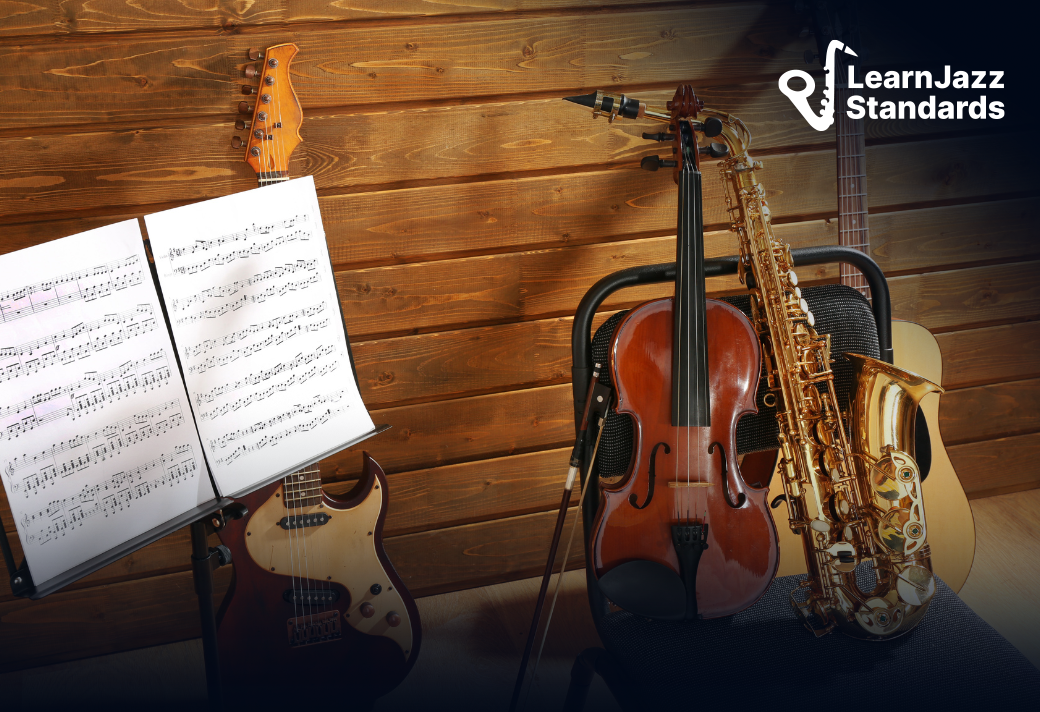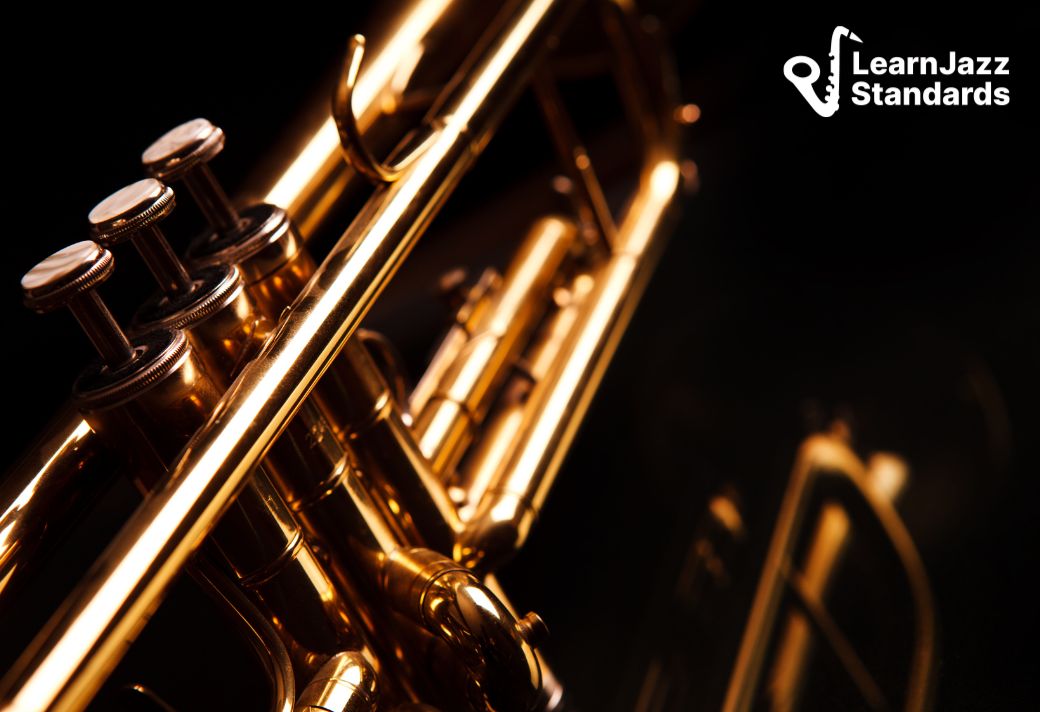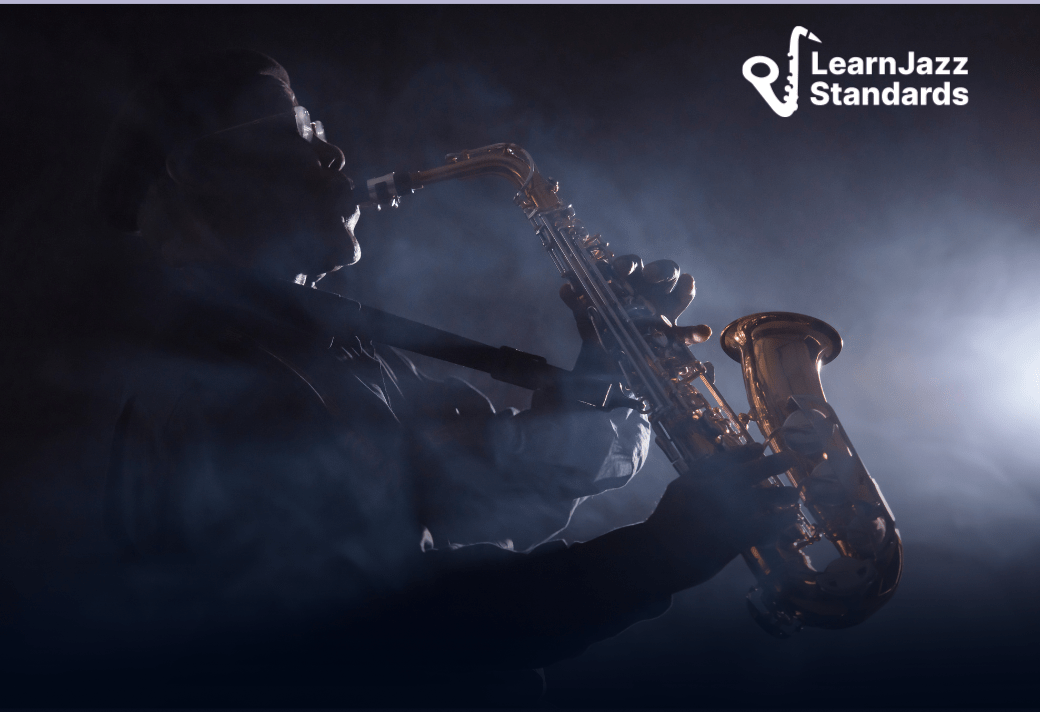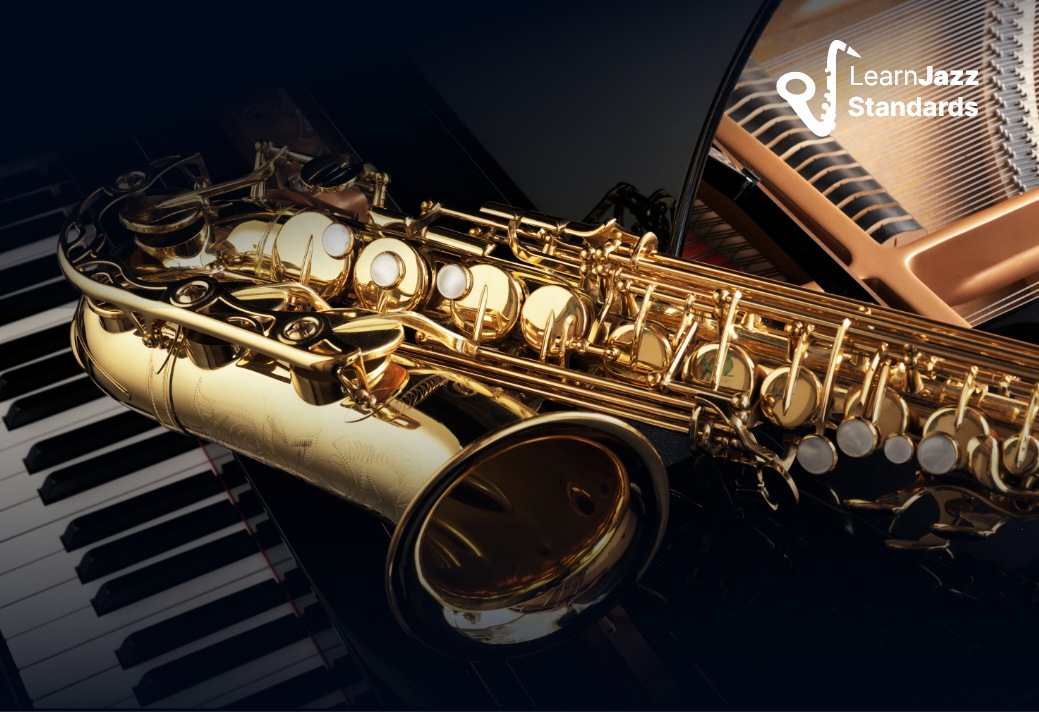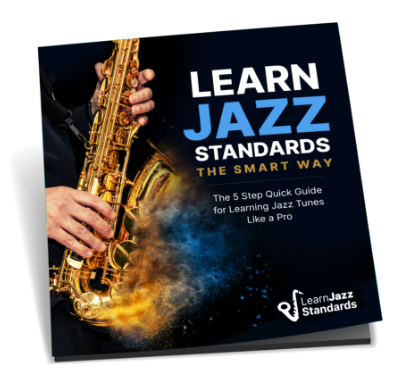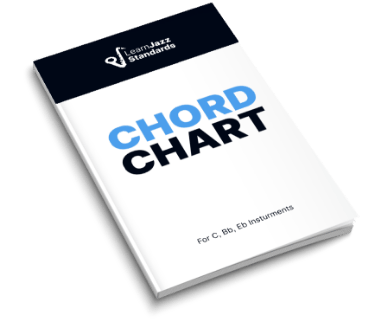To fully understand music theory, you’ll need to know what an augmented chord is. Augmented chords are essential chords that have several applications in songwriting and improvising. This article will explore everything you need to know about augmented chords!
We’ll talk about
- What an augmented chord is
- What makes an augmented triad different than other types of triads
- Which scales augmented chords come from
- How to use augmented chords in composition and improvisation
- Which jazz standards use augmented chords
If you want to take your theory chops to the next level, check out the Learn Jazz Standards Inner Circle. With in-depth master classes, courses, workshops, and an avid community, the Inner Circle has everything you need to upgrade your jazz playing and musicianship skills.
Improve in 30 days or less. Join the Inner Circle.
Table of Contents
What Is An Augmented Chord?
We have to go on a little journey to understand what an augmented chord is and isn’t. I’m going to start near the beginning and work my way towards a solid definition. In this section, we’ll define what “augmented” means in music, and then we will learn about the different triad qualities.
What Does “Augmented” Mean
In music theory, when an interval is “augmented,” it increases in size. The opposite of this is “diminished,” which makes an interval smaller. Though any interval can be augmented, when someone refers to an augmented chord, they mean a major triad with an augmented fifth.
A regular C major triad (C-E-G) has a perfect fifth interval between the root note and the fifth. A C augmented chord (C-E-G#) has a minor sixth interval between the root and the fifth.
Therefore, an augmented chord has an augmented fifth that is one half-step larger than a perfect fifth.
To better illustrate what all this means, let’s take some time to review the different types of triads. After all, an augmented chord is a triad, so we have to define what a triad is before tackling augmented chords.
Different Types of Triads
A triad is a three-note chord that contains a root note, some kind of third (major or minor), and some kind of fifth (perfect, augmented, or diminished).
Check out this article on musical intervals to learn more about musical intervals like thirds and fifths.
Based on different combinations of these intervals, musicians recognize four types of triads:

- Major Triads
- Minor Triads
- Diminished Triads
- Augmented Triads
Let’s explore each in greater detail to paint a better picture.
Major Triad
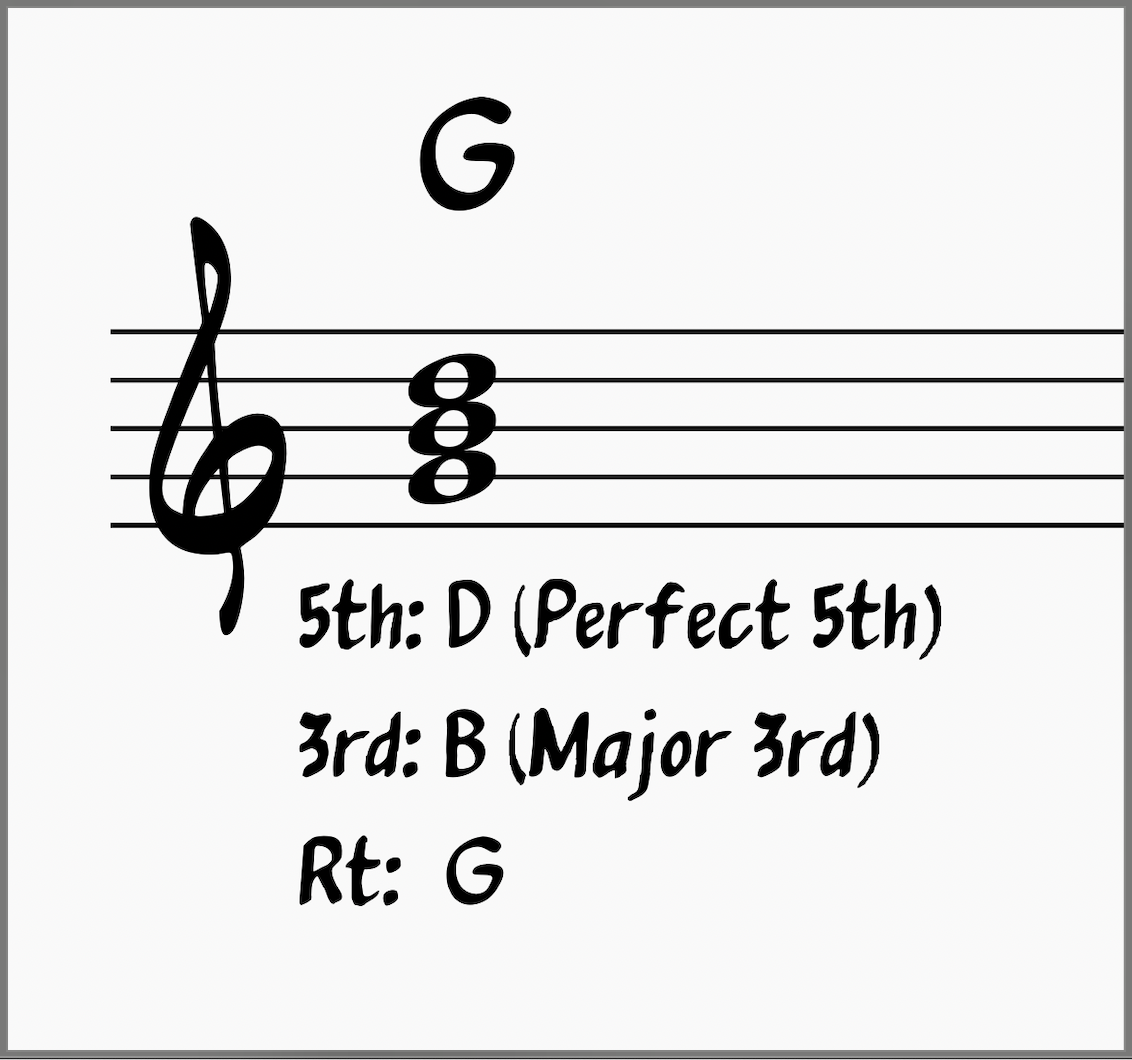
A major chord consists of a root note, a major third, and a perfect fifth. The bottom third (between the root note and the third) is a major third, while the top third (between the third and the fifth) is a minor third.
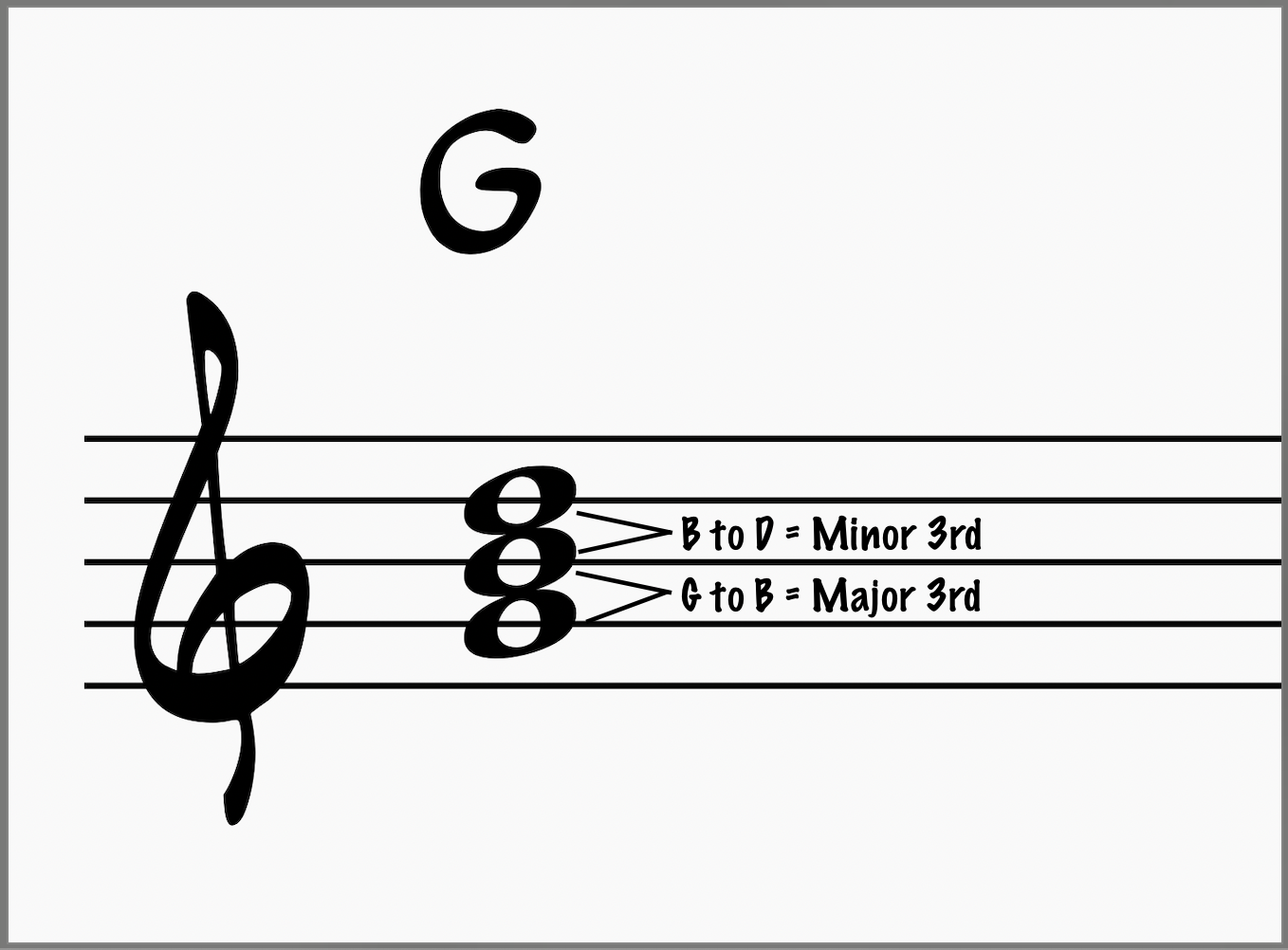
If we built a major chord from G, we’d spell our chord like so:
- 5th: D
- 3rd: B
- Rt: G
Major triads occur naturally in the major scale and are diatonic. The I, IV, and V chords are major triads in any major key. Here are all the major triads in the key of G. The I, IV, and V chords are shown in purple:

Common Chord Symbols:
- G
- Gmaj
- GM
Check out this article for more on major triads. It is guitar-focused, but the music theory is universal!
Minor Triad
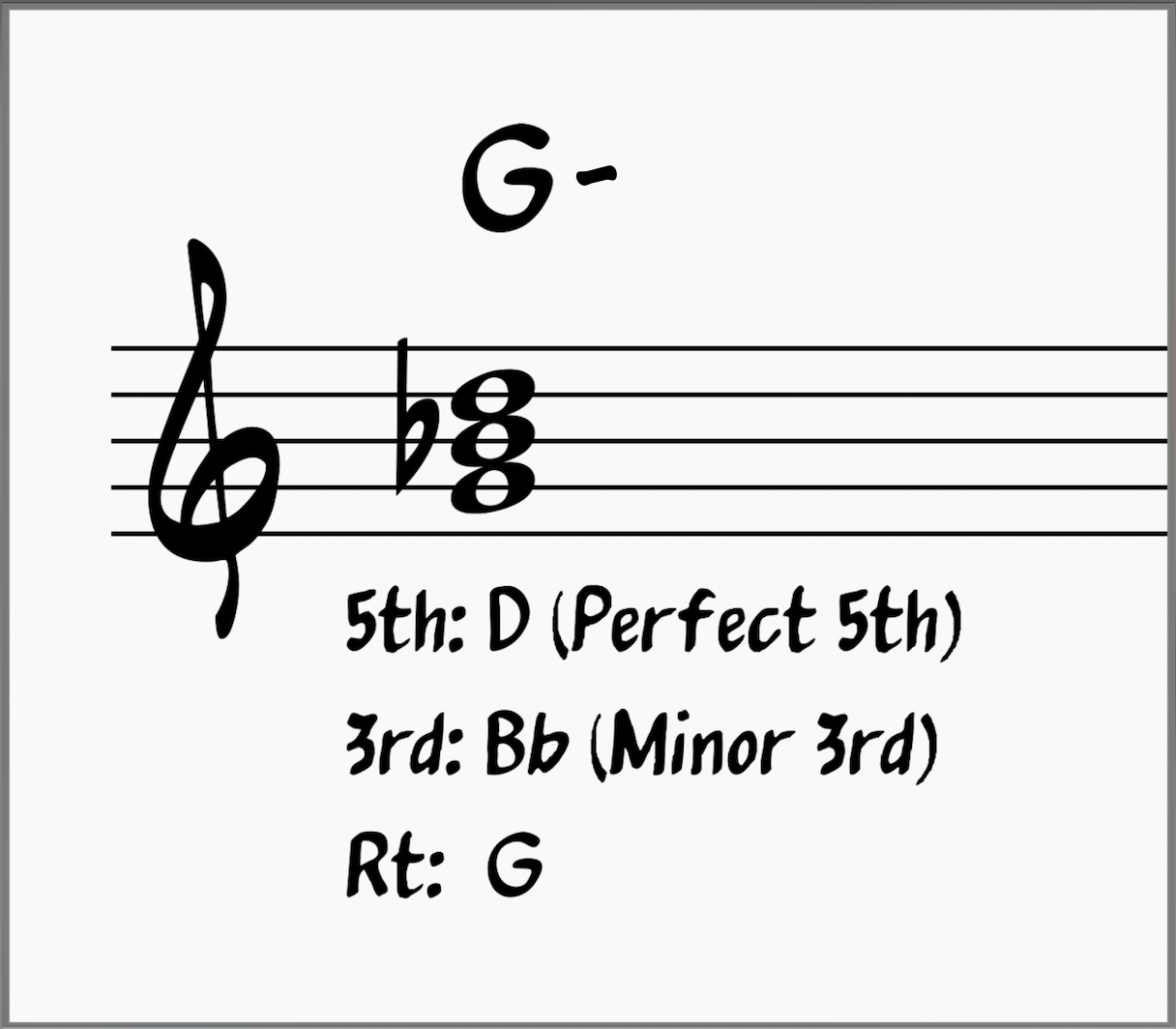
A minor chord consists of a root note, a minor third, and a perfect fifth. You can also think of a minor triad as two thirds stacked on top of one another. The bottom third (between the root note and the third) is a minor third, while the top third (between the third and the fifth) is a major third.
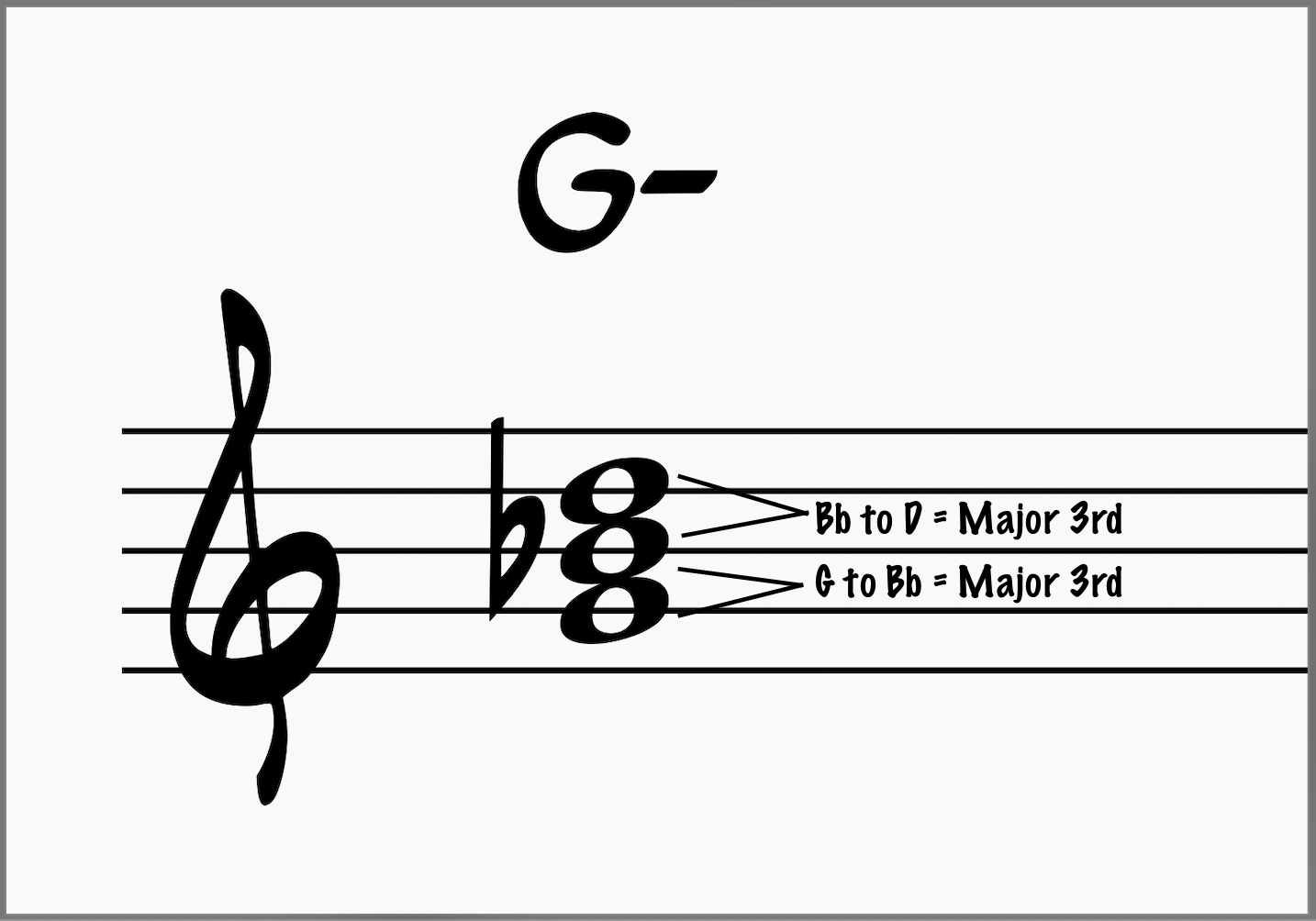
If we build a minor chord from G, we’d spell our chord like so:
- 5th: D
- 3rd: Bb
- Rt: G
Like major triads, minor triads occur naturally in the major scale. The ii, iii, and vi chords are all minor chords. They are labeled in green below:

Common Chord Symbols:
- G-
- Gmin
- Gm
Check out this article for more on minor triads. Like the previous article, it is guitar-focused, but the theory remains the same.
Diminished Triad
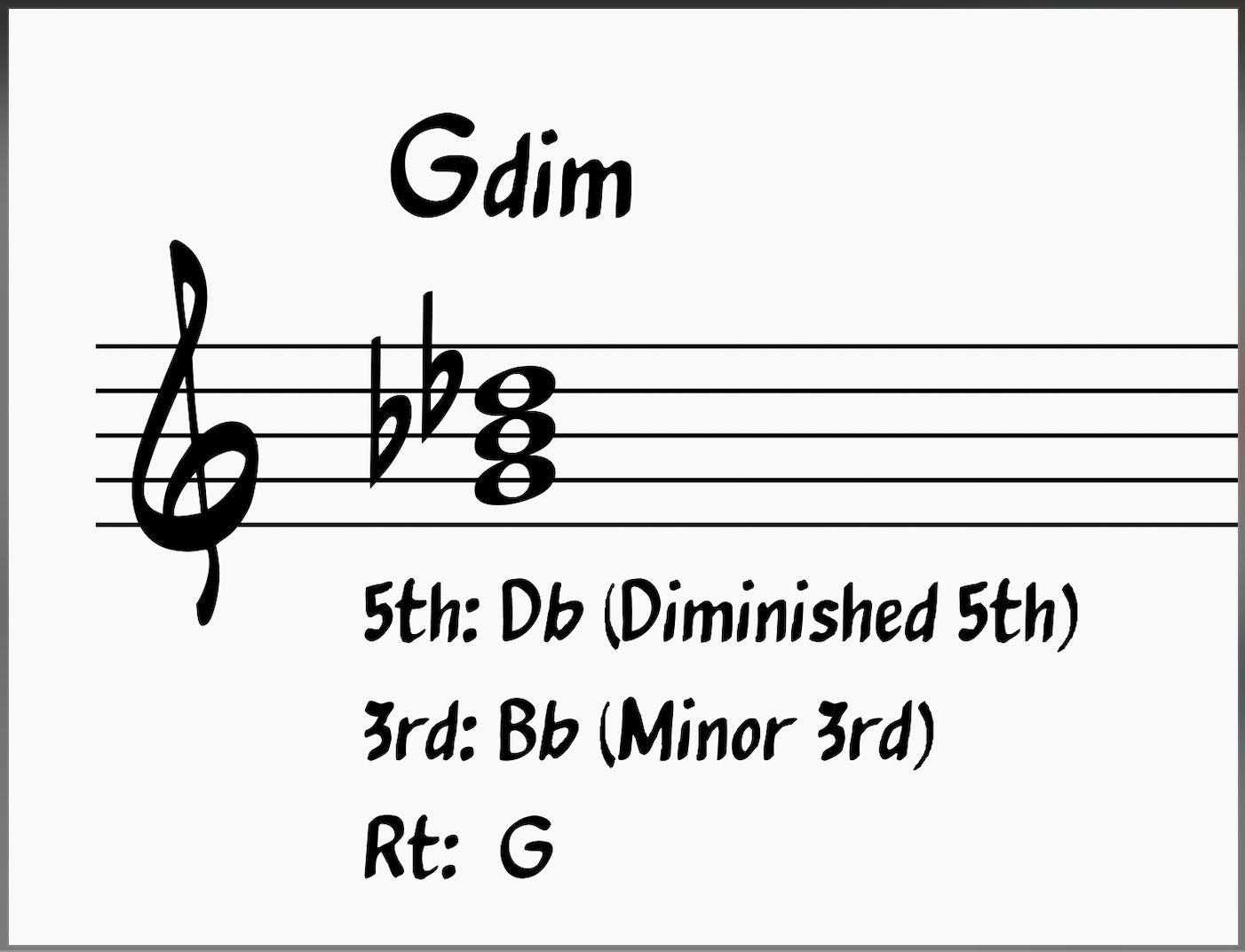
A diminished chord has a minor third interval and a diminished fifth interval. Diminished fifths are also referred to as “flat fives.” The seventh chord equivalent of the diminished chord is called a half-diminished or a “minor seven flat five” chord.
You can think of diminished chords as two minor thirds stacked on top of one another.

A diminished chord built from G would be spelled:
- 5th: Db
- 3rd: Bb
- Rt: G
Like major and minor triads, diminished triads occur naturally in the major scale and are diatonic. However, unlike major and minor triads, each major key has only one diminished chord. Check out the diminished chord below, shown in blue:

Common Chord Symbols:
- Gdim
- G°
Check out this article to dig deeper into diminished triads on guitar.
Finally… The Augmented Triad
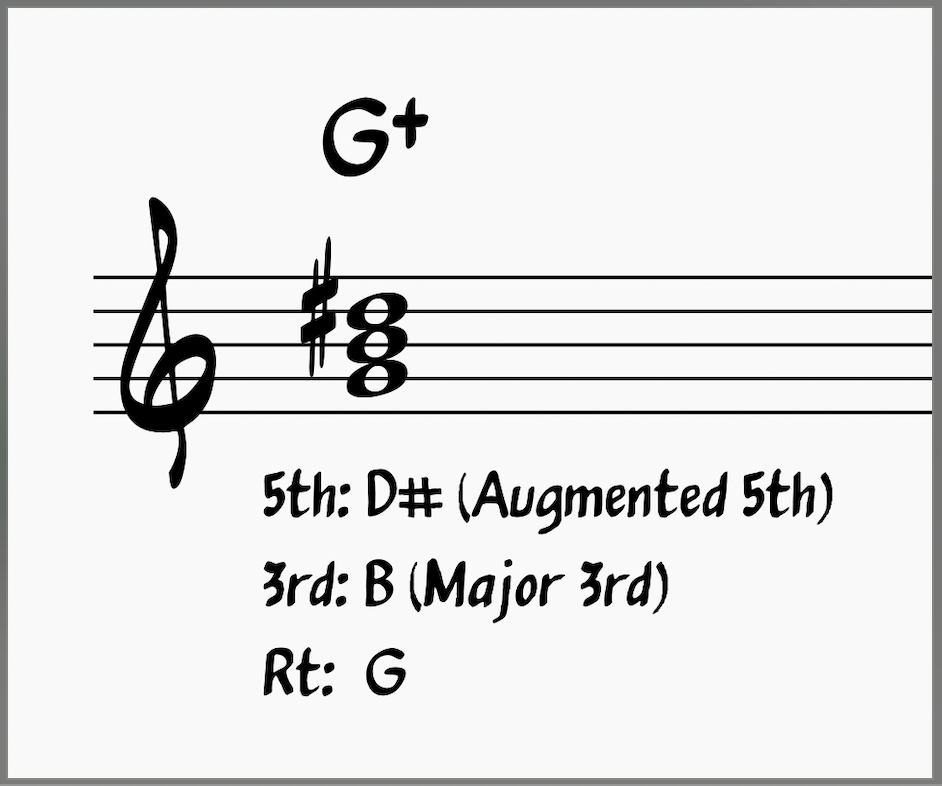
We’ve made it to augmented chords! Augmented chords have a major third and an augmented fifth interval. Augmented fifths are also called “sharp fives.” You can also think about an augmented chord as two major third intervals stacked on top of each other.
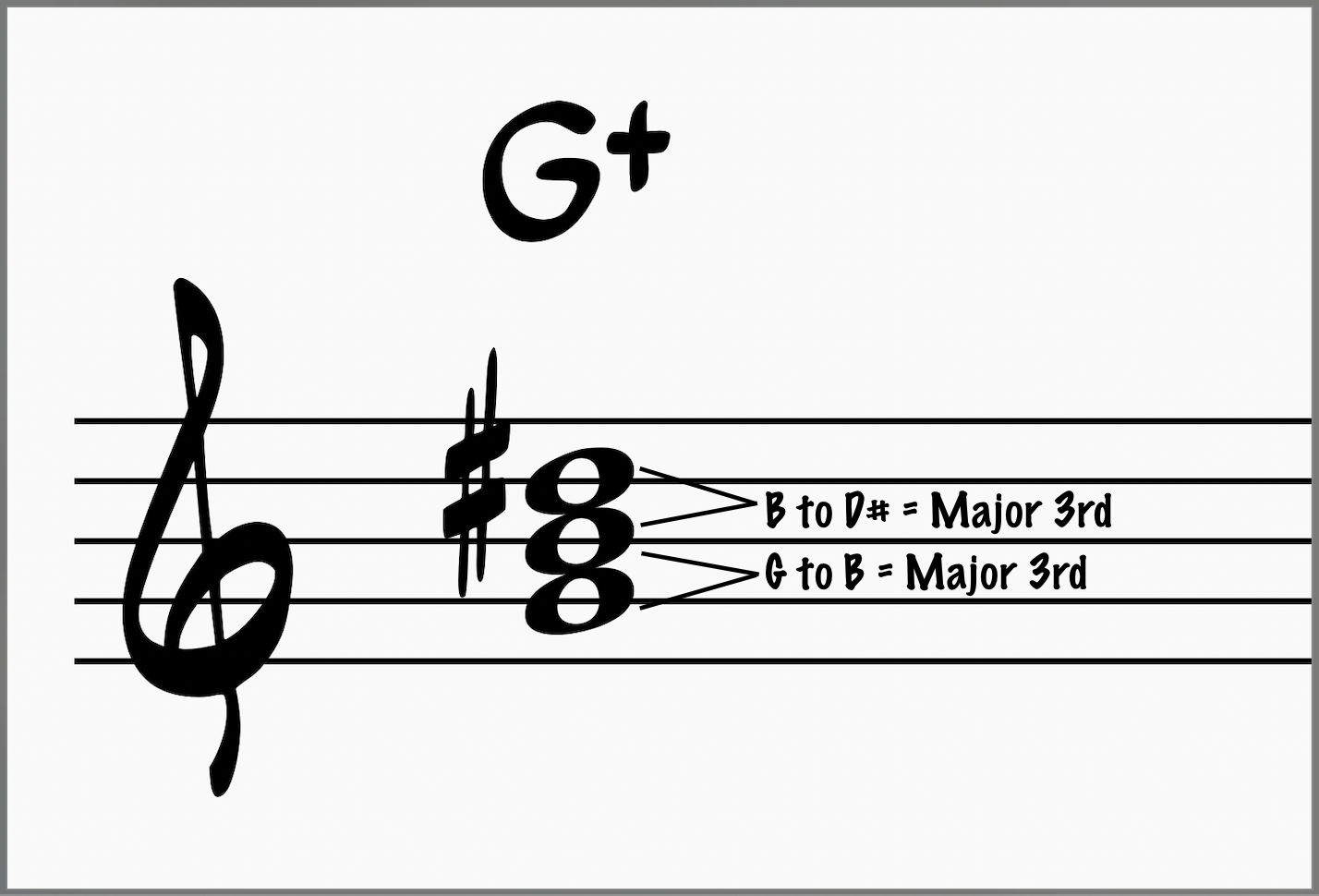
Augmented chords are the only non-diatonic triads. Unlike major, minor, and diminished triads, they can’t be built from the scale degrees of the major scale or derived modes.
So, do augmented chords have a home? As it turns out, they do! However, this home is not in any major or natural minor key.
Common Chord Symbols:
- Gaug
- G+
I’ve been using the word diatonic a lot in this article. If you are unsure what that means, check out this article on diatonic chords.
BEFORE YOU CONTINUE...
If music theory has always seemed confusing to you and you wish someone would make it feel simple, our free guide will help you unlock jazz theory secrets.
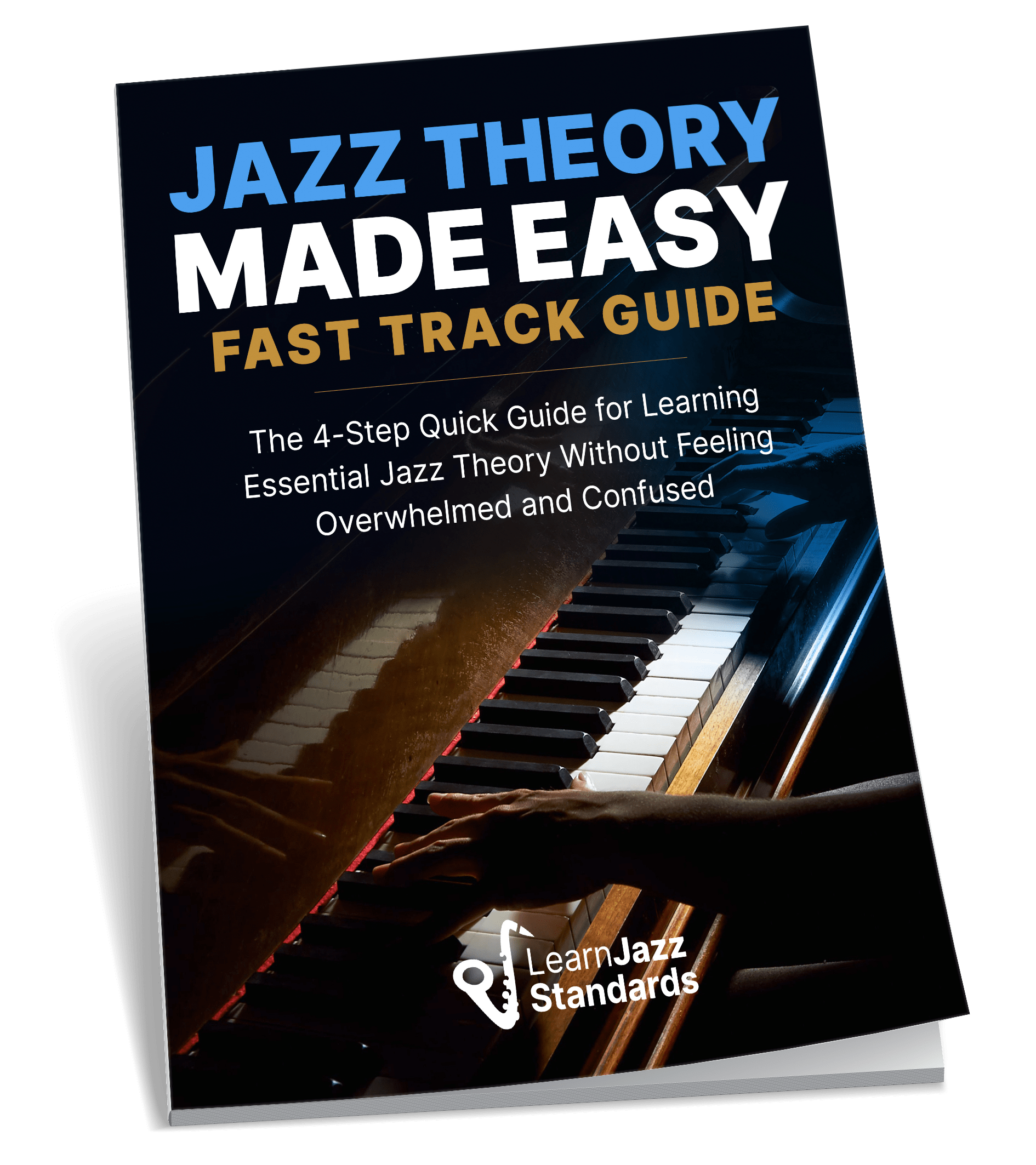
Where Do Augmented Chords Come From?
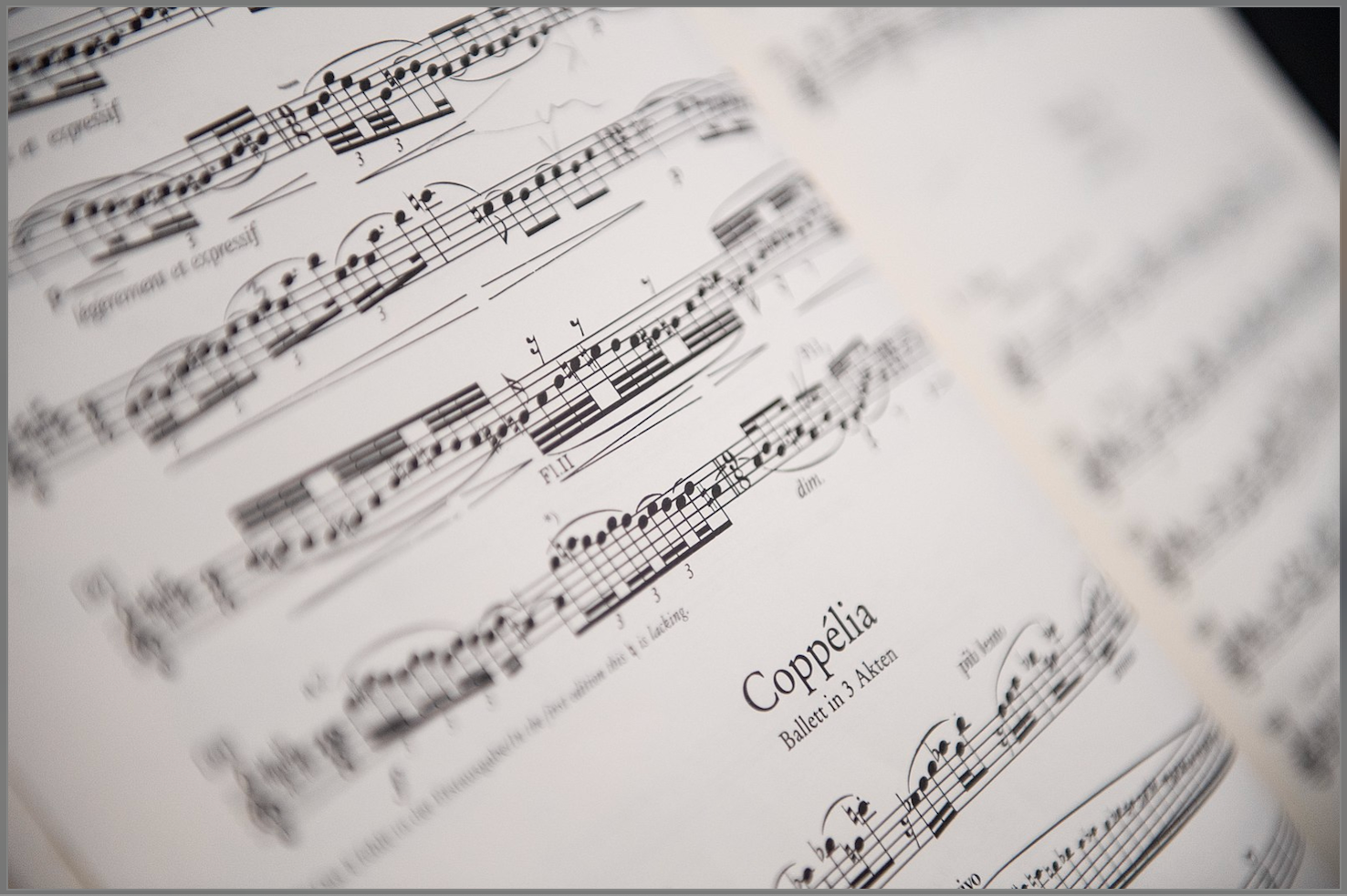
image source: Wikimedia Commons
Now that we know that augmented chords are non-diatonic, we need to discover which scales they occur naturally in.
Augmented chords occur naturally in two non-diatonic minor scales.
- The Harmonic Minor Scale
- The Melodic Minor Scale
Augmented chords also occur naturally in the whole tone scale.
Let’s start with the harmonic and melodic minor scales.
Finding The Augmented Chord In The Harmonic and Melodic Minor Scales
The harmonic and melodic minor scales share some scale degree similarities, which give each an augmented chord on its third scale degree.
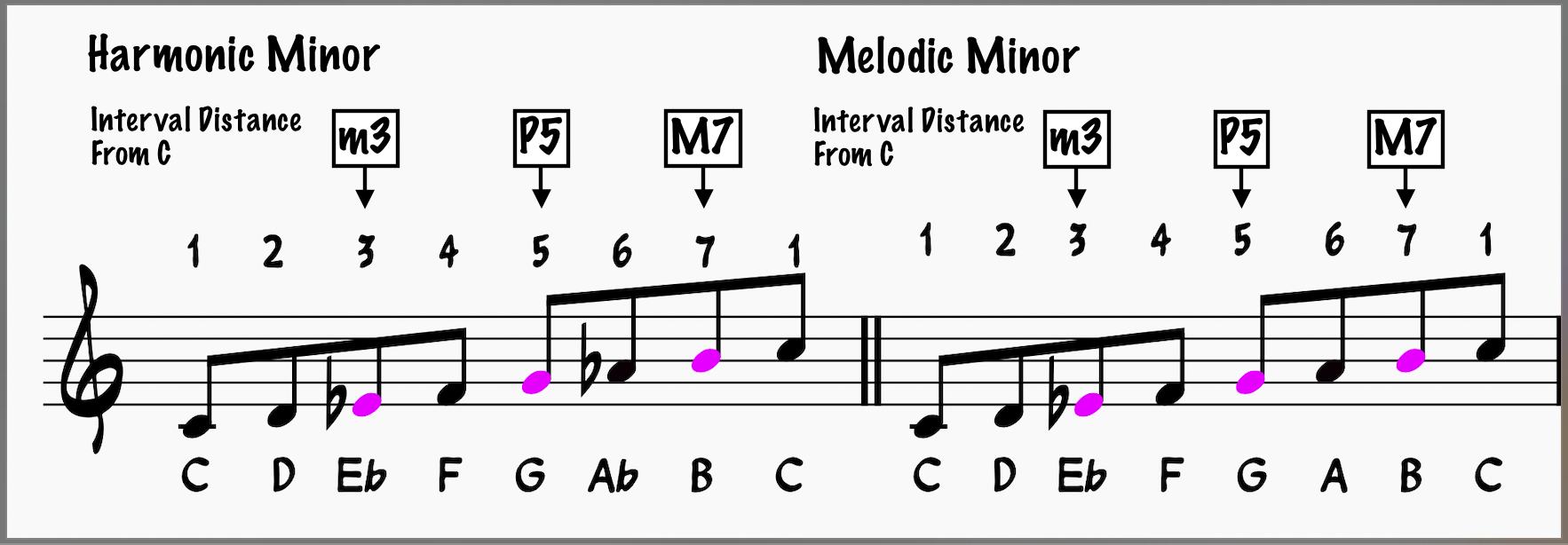
These three scale degrees are:
- a minor third scale degree (m3)
- a perfect fifth scale degree (P5)
- a major seventh scale degree (M7)
These three scale degrees make up our augmented chord. An augmented triad occurs in each scale from the third scale degree.
See the augmented chord embedded within each scale below.
The Harmonic Minor Scale
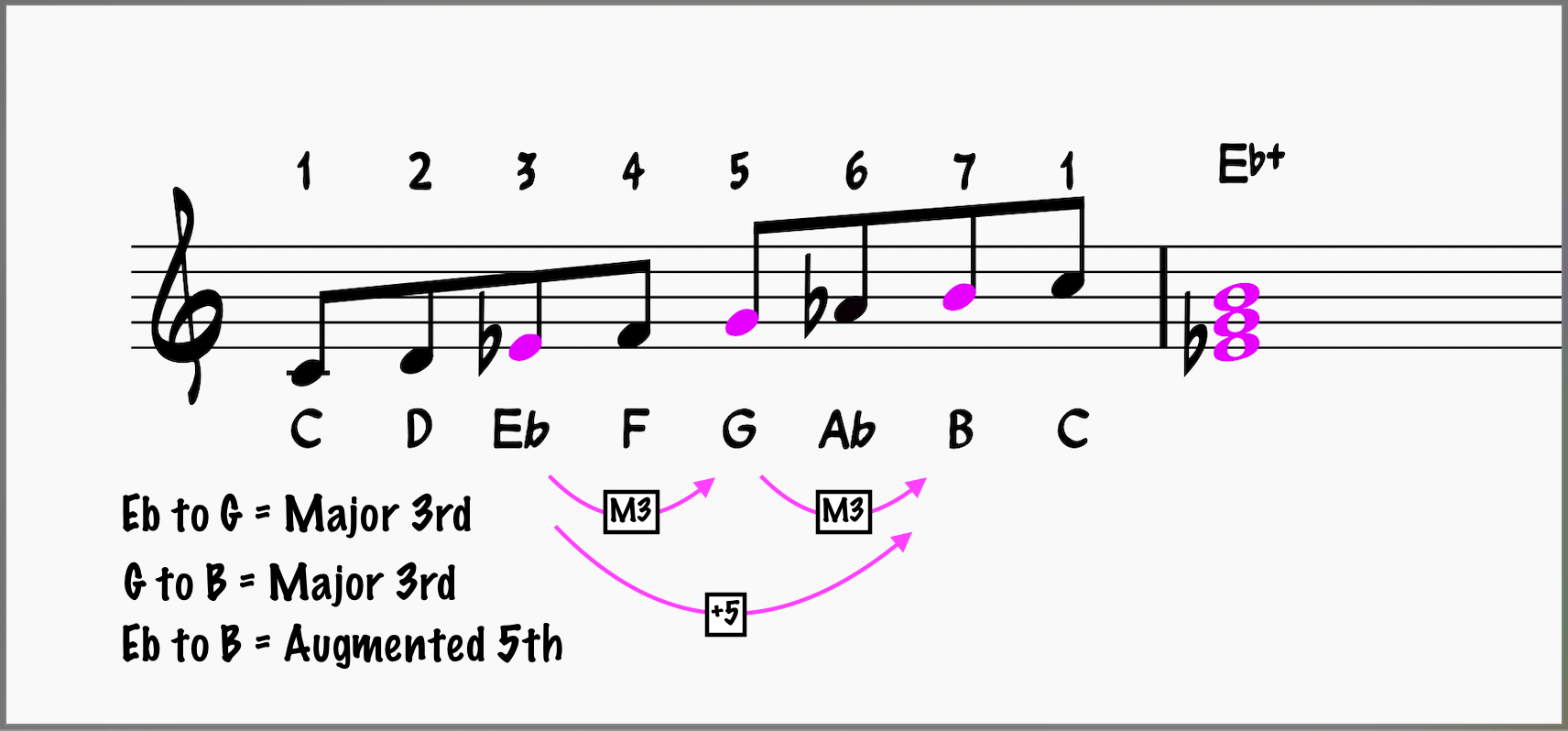
If we stack thirds on top of Eb, the third scale degree in a C harmonic minor scale, we get an Eb augmented triad.
- 5th: B
- 3rd: G
- Rt: Eb
Check out this article to learn more about the harmonic minor scale.
The Melodic Minor Scale
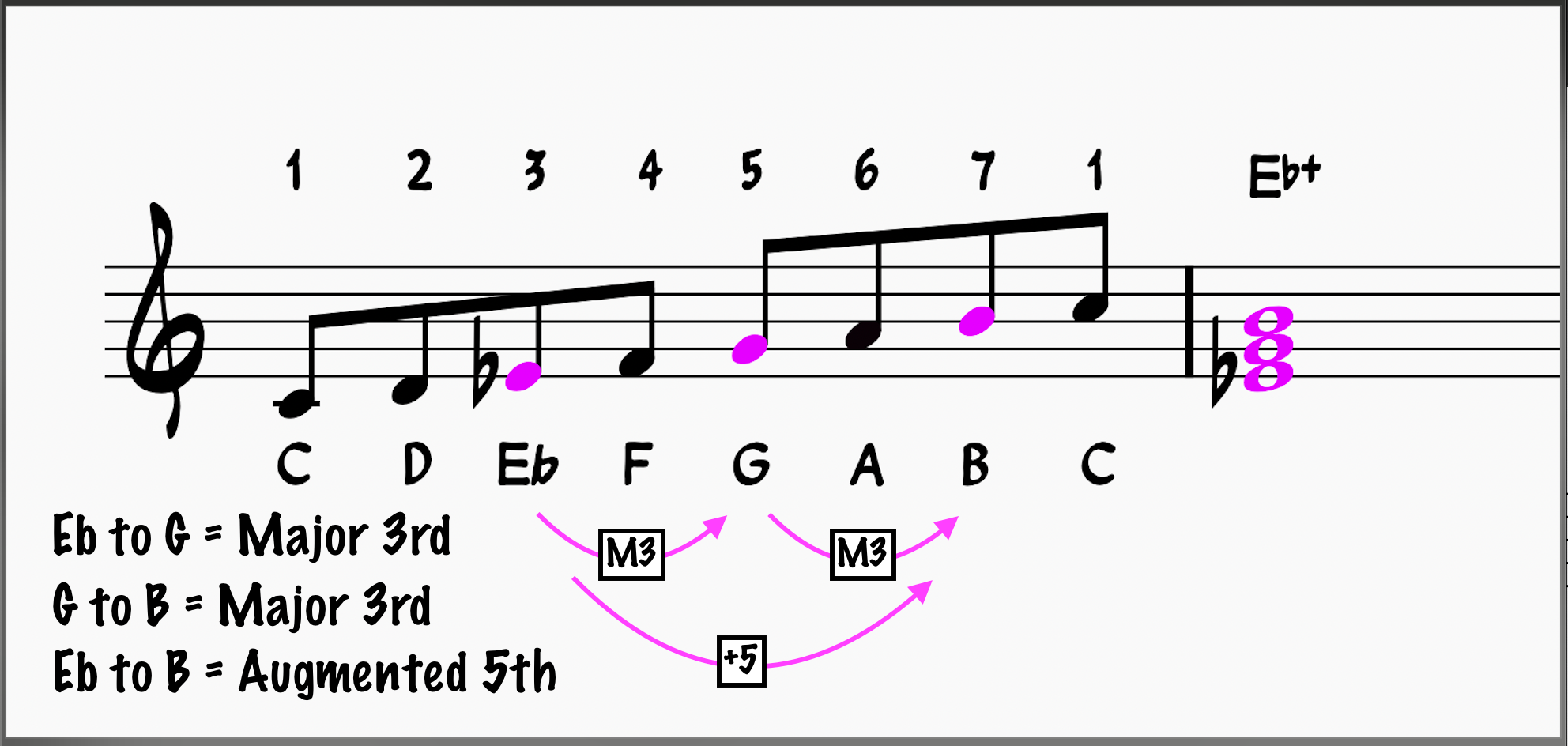
Because the melodic minor and harmonic minor scales have the same 3rd, 5th, and 7th scale degrees, you can also build the same augmented chord from the 3rd scale degree in the melodic minor scale.
- 5th: B
- 3rd: G
- Rt: Eb
Check out this article to learn more about the melodic minor scale.
Finding Augmented Chords In The Whole Tone Scale
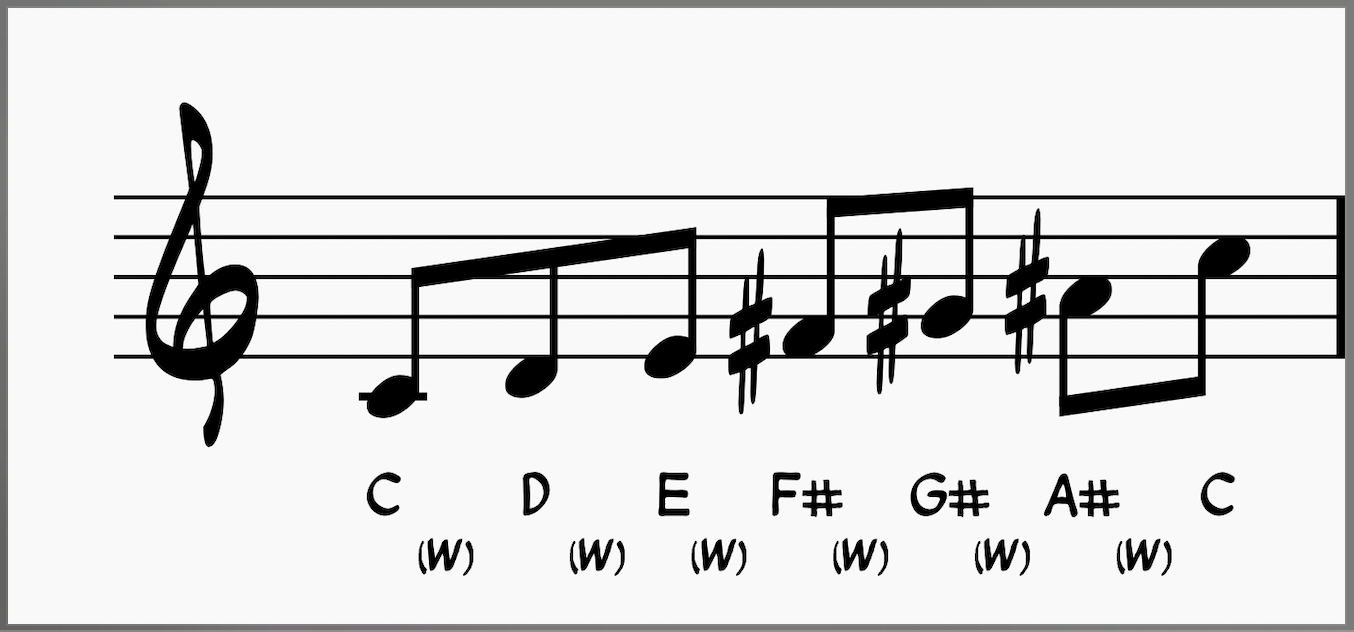
Augmented triads also occur in the whole tone scale. The whole tone scale is a six-note scale made up of whole steps. Within the whole tone scale are two augmented chords. In fact, the only chords within the whole tone scale are those two augmented chords!
If we stack thirds on C, we get a C+ chord:
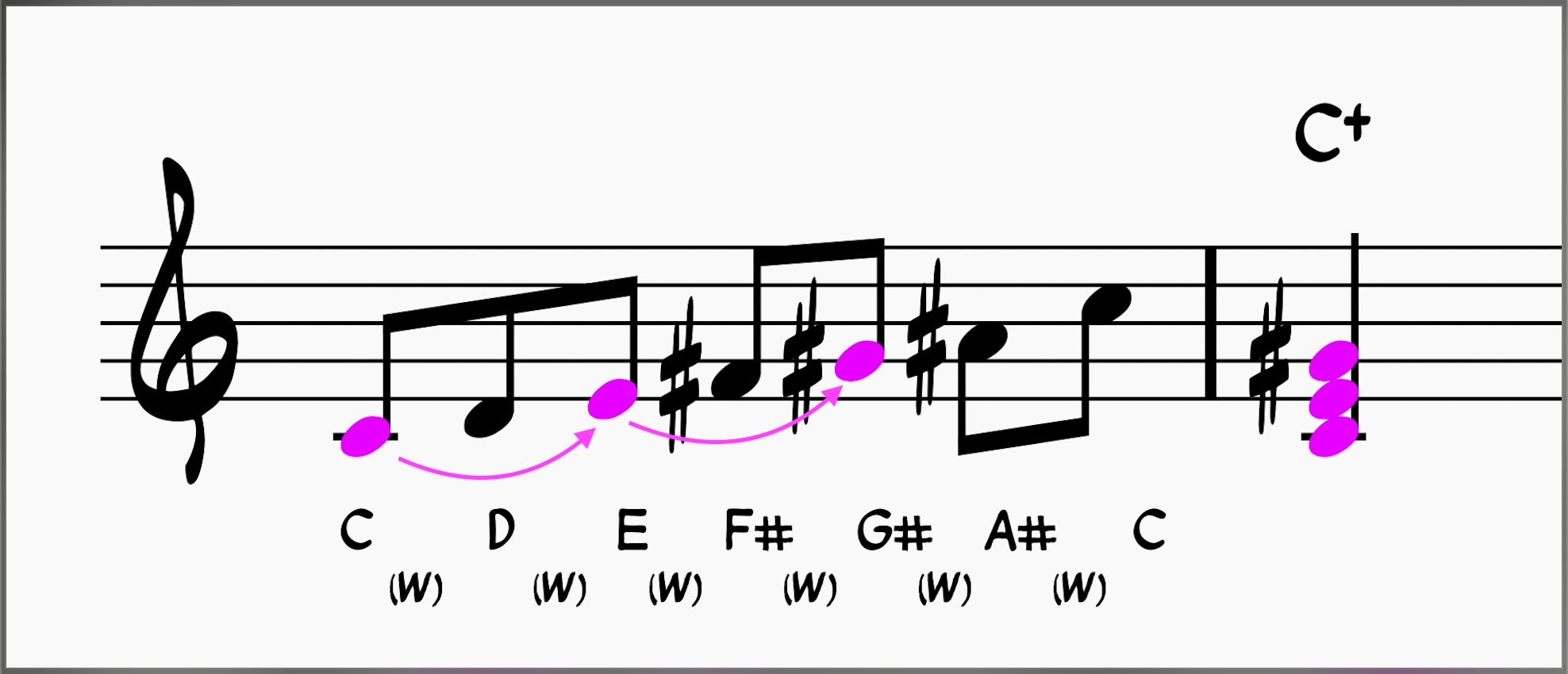
- C-E-G#-C-E-G#-C-E-G#
The next note in the scale is D. When we stack thirds on D, we get a D+ chord:
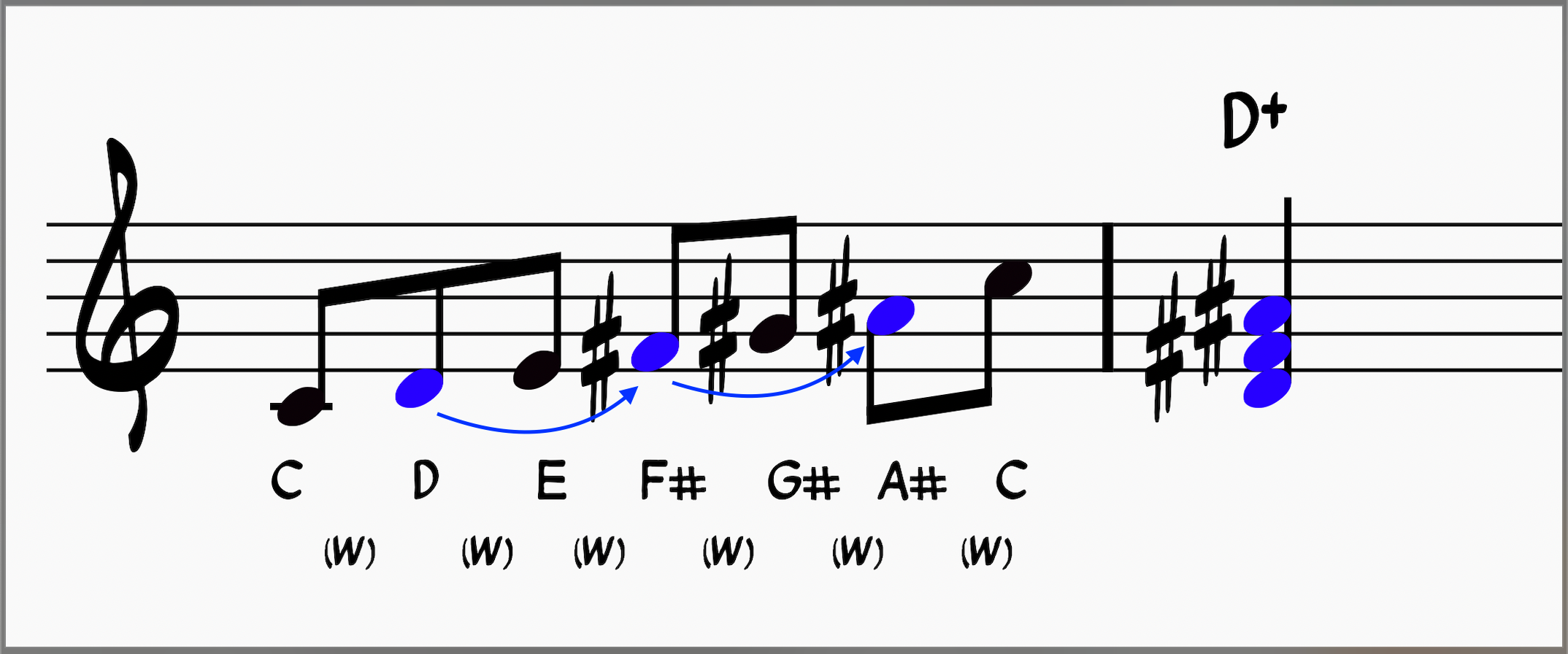
- D-F#-A#-D-F#-A#-D-F#-A#
After D, the next note is E. When we stack thirds on E, we get an inversion of the C+ chord:
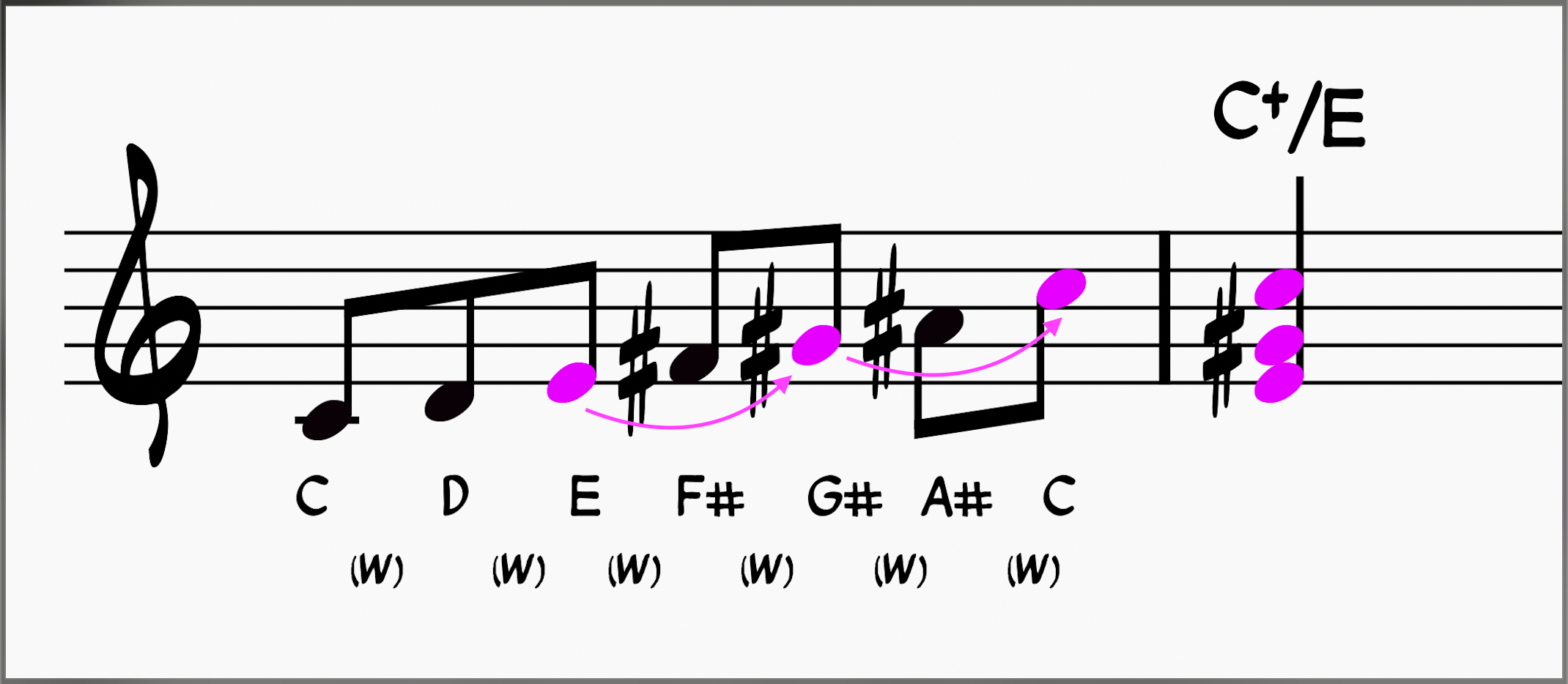
- E-G#-C-E-G#-C-E-G#-C
Check out this article to learn more about the whole tone scale.
Finding Augmented Chords In The Augmented Scale

The augmented scale is a six-note (or hexatonic) scale that consists of alternating minor thirds and half steps. It is similar to the whole tone scale in that it is hexatonic and can be broken into three major third segments (which gives us our augmented chords).
However, the augmented scale and the whole tone scale divide those major third segments differently. The augmented scale divides its major thirds into one minor third and one half-step pair, whereas the whole tone scale divides its major thirds evenly into whole steps.
In the image below, the augmented scale is on the top line, and the whole tone scale is on the bottom.
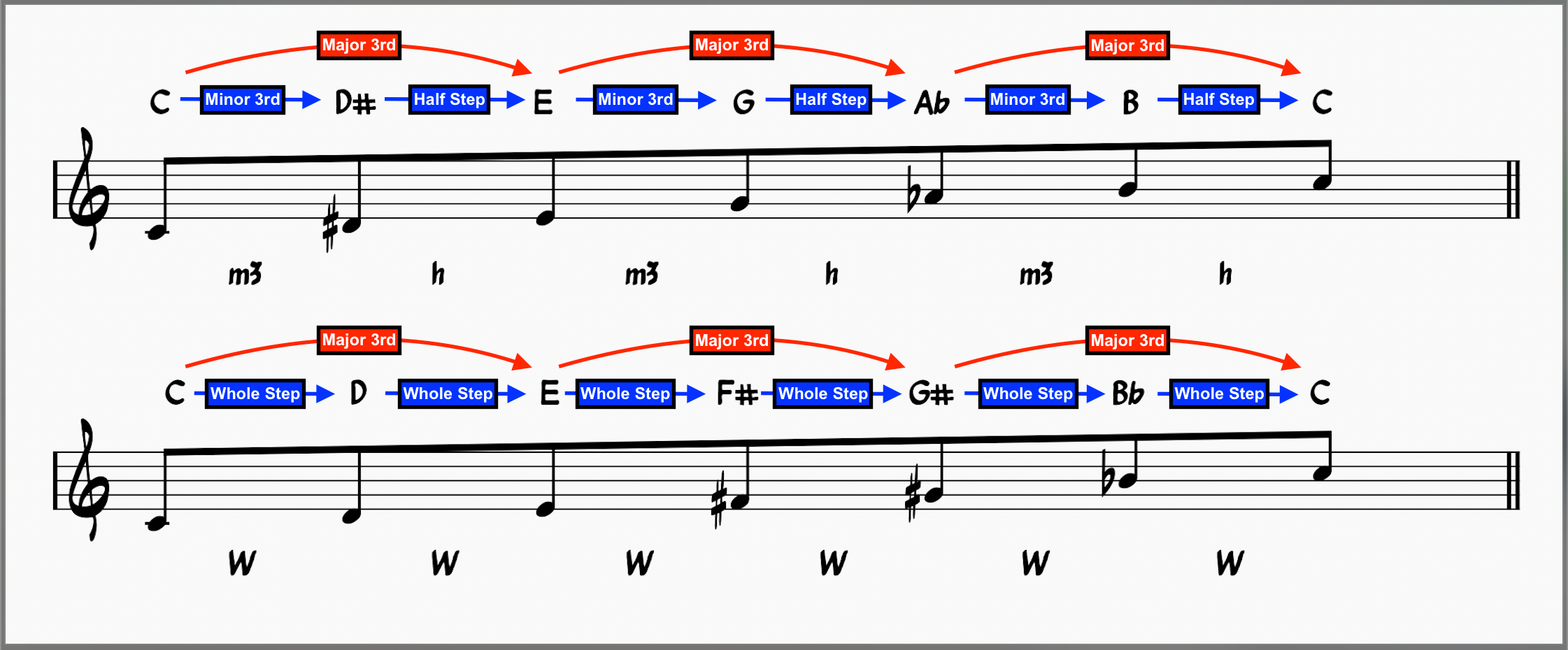
Like the whole tone scale, there are two augmented chords within the augmented scale. These augmented chords are a minor third apart. Below, you’ll see a C augmented triad and an Eb augmented triad built from the scale degrees of the augmented scale.

How Do You Use Augmented Chords?
Now that we know what augmented chords are and where they come from, it’s time to learn how to use them! Augmented chords are found in many music genres, from jazz and classical music to pop music.
Because they are non-diatonic, they lack a clear tonal center. They sound ambiguous and unresolved. Usually, these chords instill a sense of unease or instability in a chord progression. In this section, we’ll talk about Maj7#5 chords and 7#5 (or 7b13) chords.
Check out this article if you want to learn more about 7th chords. Also, check out this one to learn about altered chord extensions such as the #5 or b13.
Maj7#5 Chords: Borrowing The III+ Chord From Harmonic or Melodic Minor

Sometimes, composers borrow a chord from a different key or scale to add color and tension to a chord progression. When you encounter a III+ chord in a chord progression, the composer borrowed from harmonic or melodic minor to infuse the augmented sound into their progression.
We’ll examine a jazz standard that uses the III+ chord below to find an example of this type of borrowed chord.
Check out this article to learn more about borrowed chords.
In Minor ii-V Chord Progressions
ii-V-I progressions are the cornerstone of jazz standards. Many jazz standards are made entirely of ii-Vs. A common variant of the ii-V-I chord progression is the minor ii-V, which has slightly different chord qualities and tends to resolve to a minor chord instead of a major chord.
Here is a major ii-V-I chord progression in the key of C. The C is the I, the D- is the ii, and the G7 is the V.

The V chord is often altered when we play the minor ii-V variant. You can choose a few options when altering the V chord in minor ii-Vs. Here are some of them:
- b9
- b13
- #5
If you choose the #5 or the b13 version, you’ll end up including that minor sixth interval that makes an augmented chord augmented. You must be careful not to play a b9 or #9! Only a natural 9 works with augmented chords.
If you see a b9 or #9, playing the whole tone scale or augmented triad pairs may clash with the harmony.

A G7#5 is spelled:
- 7: F
- 5th: D#
- 3rd: B
- Rt: G

A G7b13 is spelled:
- b13th: Eb
- 7th: F
- 5th: D
- 3rd: B
- Rt: G
This variant can include the natural 5th in addition to the b13th. However, you can opt for an augmented triad from G when voicing this chord.
Check out this article to learn more about the ii-V-I progression.
Two Jazz Standards That Use Augmented Chords
Here are a few of my favorite jazz standards that use augmented chords in their chord progressions.
Iris – Wayne Shorter
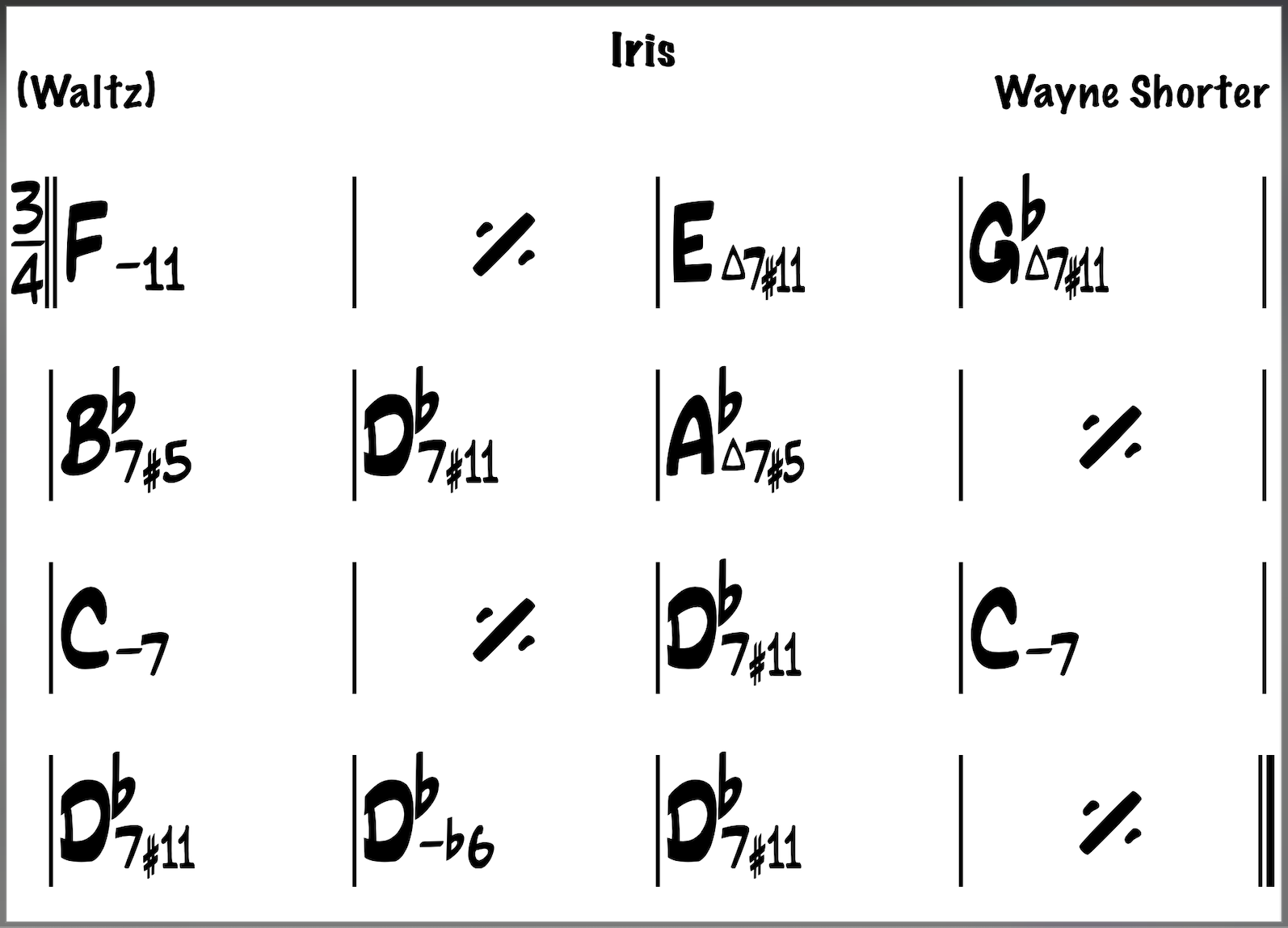
Iris is a beautiful tune by Wayne Shorter (who loved using augmented chords). This song takes advantage of augmented major seventh chords and augmented dominant chords. Both augmented major seventh and augmented dominant chords have an augmented triad in the base.
This tune is in the key of F minor, so the Abmaj7#5 is a III+. We discussed this use above. This chord is borrowed from F harmonic minor or F melodic minor.
Juju – Wayne Shorter
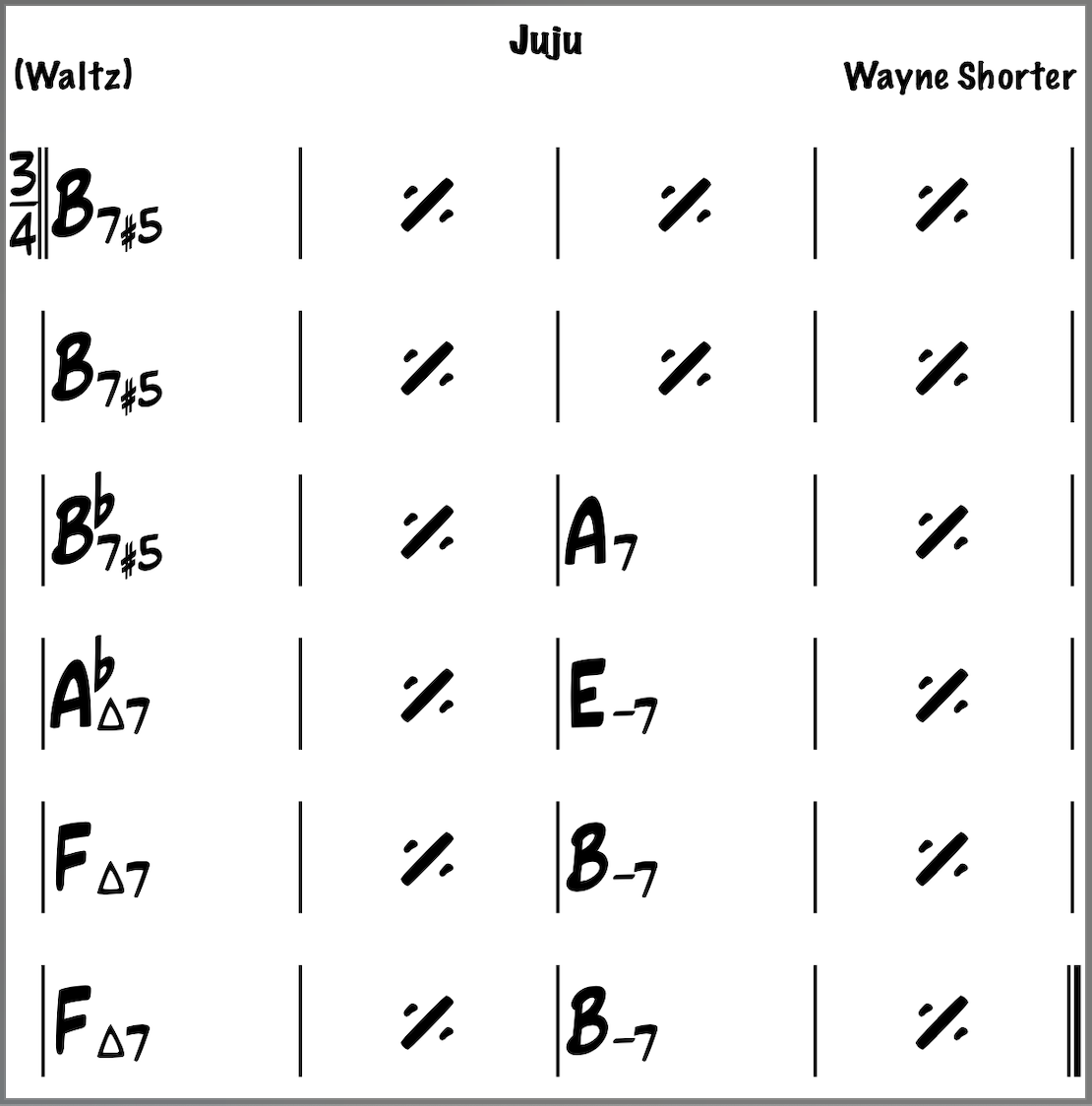
Juju is another Wayne Shorter composition that takes full advantage of the whole tone sound. This jazz standard uses augmented dominant chords in the first half. These chords add an intensity or anxiety that seems to resolve in the second half.
However, we’re back in augmented territory when that second half ends.
Augmented Chords and Jazz Improvising
So, how do you apply augmented chords and the whole tone sound in your jazz solos? As mentioned above in the section on minor ii-Vs, we can play augmented triads over altered dominant chords with a #5 or a b13.
If you want to play more than just an augmented triad from the root of the dominant chord, you have to be mindful of the chord symbol.
Augmented Triad Pairs A Whole Step Apart

These augmented chords hit the essential chord tones and extensions in a G9#5 chord.
G Augmented Chord:
- D# – #5
- B – 3rd
- G – Rt
A Augmented Chord:
- E# (F) – 7th
- C# – b5/#11
- A – natural 9
This is one practical way to apply augmented chords in your jazz improv! But, if you want to learn more secrets of jazz improvisation, you should check out the Learn Jazz Standards Inner Circle.
Take Your Jazz Playing To The Next Level. Join The Learn Jazz Standards Inner Circle.
The Learn Jazz Standards Inner Circle has everything you need to supercharge your musicianship and jazz playing skills. Blast through the practice plateaus holding you back from your true musical potential!
Improve in 30 Days or Less. Join the Inner Circle.


